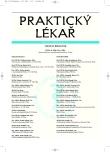Cerebrovascular complications of HIV infection.
Authors:
L. Machala 1; R. Černý 2
Authors‘ workplace:
AIDS centrum FN Na Bulovce, Praha
III. klinika infekčních a tropických nemocí 1. LF UK, Praha
Vedoucí lékař: doc. MUDr. Marie Staňková, CSc.
1; Neurologická klinika 2. LF UK a FN Motol, Praha
Přednosta: doc. MUDr. Martin Bojar, CSc.
2
Published in:
Prakt. Lék. 2008; 88(11): 635-636
Category:
Reviews
Overview
With the prolonged life-expectancy brought about by the effectiveness of combination antiretroviral therapy, the spectrum of complications of HIV infection has also changed. Cerebrovascular diseases have become one of the important health problems in HIV positive patients, as in the normal population. The HIV infection itself, and the toxicity of some antiretroviral medicines, plays an important role in the pathogenesis of cerebrovascular disorders and therefore physicians treating HIV positive patients must pay great attention to the prevention, diagnosis and therapy of these important complications.
Key words:
HIV, cerebrovascular, metabolic syndrome, hyperlididemia, antiretroviral therapy.
Sources
1. Kwong, G., Ghani, A., Rode, R. et al. Cardiovascular manifestations in human immunodeficiency virus-infected patients. Am. J. Cardiol. 2008, 102, p. 635-642.
2. Cole, J., Pinto, A., Hebel, J. et al. Acquired immunodeficiency syndrome and the risk of stroke. Stroke 2004, 35, p. 51-56.
3. Goodkin, K., Wilkie, F., Concha, M. et al. Aging and neuro-AIDS conditions and the changing spectrum of HIV-1-associated morbidity and mortality. J. Clin. Epidemiol. 2001, 54, S35-S43.
4. d’Arminio Monforte, A., Cinque, P., Mocroft, A. et al. Changing incidence of central nervous system diseases in the EuroSIDA cohort. Ann. Neurol. 2004, 55, p. 320-328.
5. d’Arminio Monforte, A., Sabin, C., Phillips, A. et al. Cardio- and cerebrovascular events in HIV-infected persons. AIDS 2004, 18, p. 1811-1817.
6. Gorczyca, I., Stanek, M., Podlasin, B. et al. Recurrent cerebral infarcts as the first manifestation of infection with the HIV virus. Folia Neuropathol. 2005, 43, p. 45-49.
7. Ortiz, G., Koch, S., Romano, J. et al. Mechanisms of ischemic stroke in HIV-infected patients. Neurology 2007, 68, p. 1257-1261.
8. Engstrom, J., Lowenstein, D., Bredsen, D. Cerebral infarctions and transient neurologic deficits associated with HIV. Am. J. Med. 1989, 86, p. 528-532.
9. Lortholary, O., Genereau, T., Gullevin, I. Viral vasculitis not related to HBV, HCV and HIV. Pathol. Biol. 1999, 47, p. 248-251.
10. Picard, O., Brunereau, L., Pelosse, B. et al. Cerebral infartion associated with vasculitis due to varicella zoster virus in patients infected with the human immunodeficiency virus. Biomed. Pharmacother. 1997, 51, p. 449-454.
11. Larranaga, G., Forastiero, R., Carreras, L.O., Alonso, B. Different types of antiphospholipid antibody in AIDS - a comparison with syphilis and antiphospholipid syndrome. Throm. Res. 1999, 96, p. 19-25.
12. Rubbert, A., Bock, E., Schwab, J. et al. Anticardiolipi antibodies in HIV infection: association with cerebral perfusion defects as detected by 99mTc-HMPAQ-Spect. Clin. Exp. Immunol. 1994, 98, p. 361-368.
13. Fontas, E., van Leth, F., Sabin, C. et al. Lipid profiles in HIV-infected patients receiving combination antiretroviral therapy: are different antiretroviral drugs associated with different lipid profiles? JID 2004, 189, p. 1056-1074.
14. John, M., Nolan, D., Mallal, S. Antiretroviral therapy and the lipodystrophy syndrome. Antivir. Ther. 2001, 6, p. 9-20.
15. Martin Lde, S., Pasquier, E., Roudaut, N. et al. Metabolic syndrome: a major risk factor for atherosclerosis in HIV-infected patients (SHIVA study). Presse Med. 2008, 37, p. 579-584.
16. Gazzard, B., Moyle, G. Does atazanavir cause lipodystrophy? J. Antiretr. Ther. 2004, 9, p. 41-44.
17. Carr, A., Samaras, K., Burton, S. A syndrome of peripheral lipodystrophy, hyperlipidemia and insulin resistance in patients receiving HIV protease inhibitors. AIDS 1998, 12, F51-F58.
18. Kwong, G., Ghani, A., Rode, R. et al. Comparison of the risks of atherosclerotic events versus death from other causes associated with antiretroviral use. AIDS 2006, 20, p. 1941-1950.
19. Maggi, P., Lillo, A., Perilli, F. et al. Colour-Doppler ultrasonography of carotid vessels in patients treated with antiretroviral therapy: a comparative study. AIDS 2004, 18, p. 1023-1028.
20. Currier, J., Kendall, M., Zackin, R. et al. Carotid artery intima-media thickness and HIV infection: traditional risk factors overshadow impact of protease inhibitor exposure. AIDS 2005, 19, p. 927-933.
21. Evatt, B. HIV Infection and thrombocytopenia. Curr. Hematol. Rep. 2005, 4, p. 149-153.
22. Ahmed, S., Sadiq, A., Siddiqui, A. et al. Thrombotic thrombocytopenic purpura: a rare cause of thrombocytopenia in HIV-infected hemophiliacs. Ann. Hematol. 2004, 83, p. 253-255.
23. Bartlett, J., Gallant, J. 2001-2002 Medical Management of HIV infection. John Hopkins University, Division of Infectious Diseases. Dostupné z www.hiv.net/link/.php?d=16, 2001.
24. Andersen, S., Skullerud, K. Hypoxic/ischaemic brain damage, especially pallidal lesions, in heroin addicts. Forensic. Sci. Int. 1999, 102, p. 51-59.
25. Raso, A., Visentin, I., Zan, S. et al. Vascular pathology of surgical interest in drug addicts. Minerva Cardioangiol. 2000, 48, p. 287-296.
26. Fitch. K., Anderson, E., Hubbard, J. et al. Effects of a lifestyle modification program in HIV-infected patients with the metabolic syndrome. AIDS 2006, 20, p. 1843-1850.
27. Salyer, J., Lyon, D., Settle, J. et al. Coronary heart disease risks and lifestyle behaviors in persons with HIV infection. J. Assoc. Nurses AIDS Care 2006, 17, p. 3-17.
28. Bartlett, J., Gallant, J. Medical management of HIV infection. Baltimore: Johns Hopkins Medicine Health Publishing Business Group, 2004.
29. Chuck, S., Penzak, S. Risk-benefit of HMG-CoA reductase inhibitors in the treatment of HIV protease inhibitor-related hyperlipidaemia. Expert Opin. Drug Saf. 2002, 1, p. 5-17.
30. Williams, D., Feely, J. Pharmacokinetic-pharmacodynamic drug interactions with HMG-CoA reductase inhibitors. Clin. Pharmacokinet. 2002, 41, p. 343-370.
Labels
General practitioner for children and adolescents General practitioner for adultsArticle was published in
General Practitioner

2008 Issue 11
Most read in this issue
- Cryptococcal meningitis in a patient with undiagnosed HIV infection
- HIV encephalopathy
- Pneumocystis pneumonia in a patient with newly diagnosed chronic retroviral infection
- Current options for active immunization of HIV infected patients
